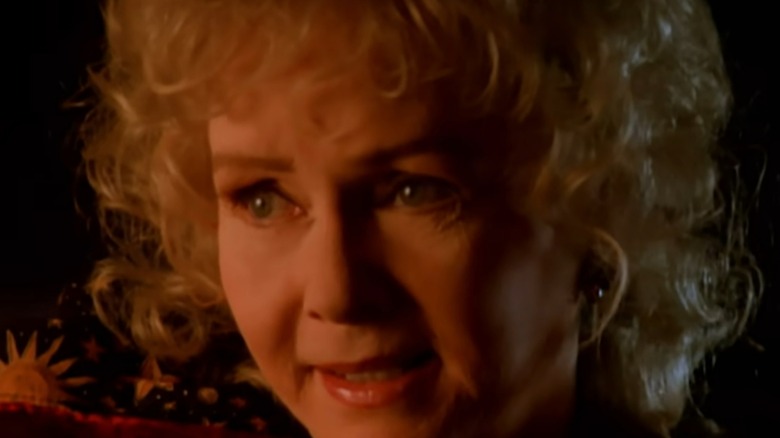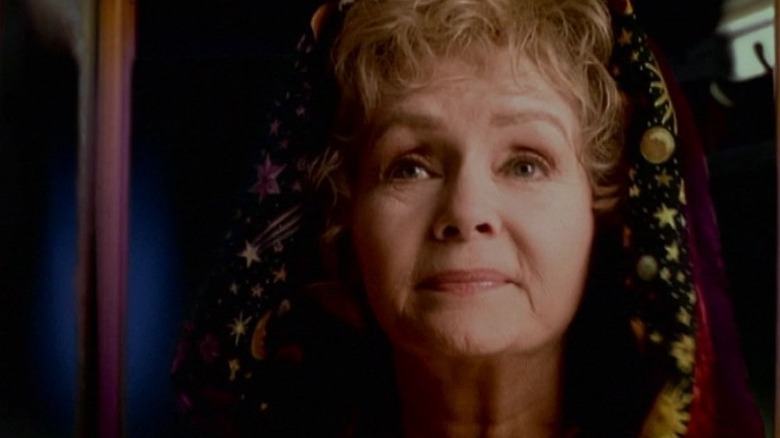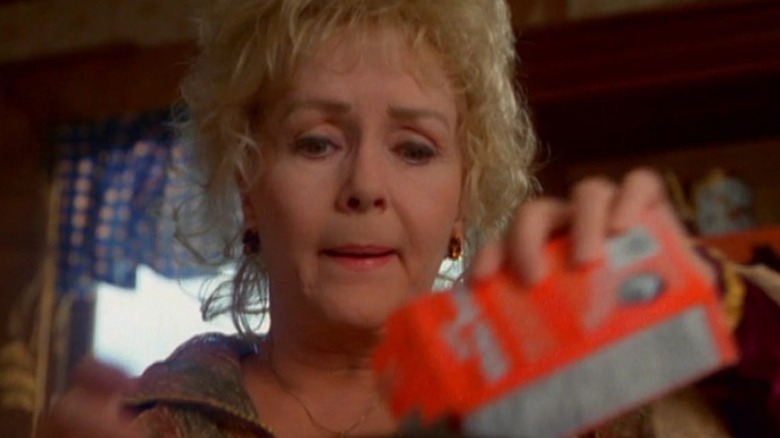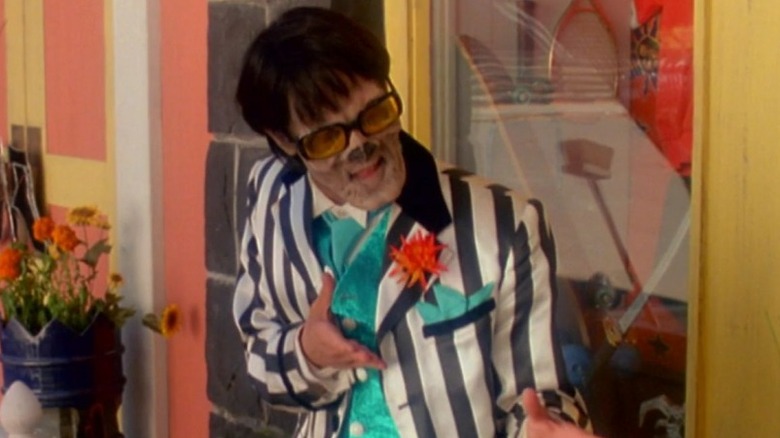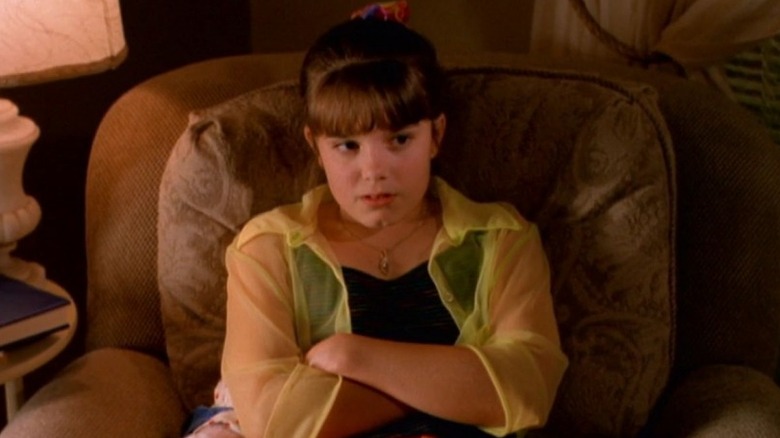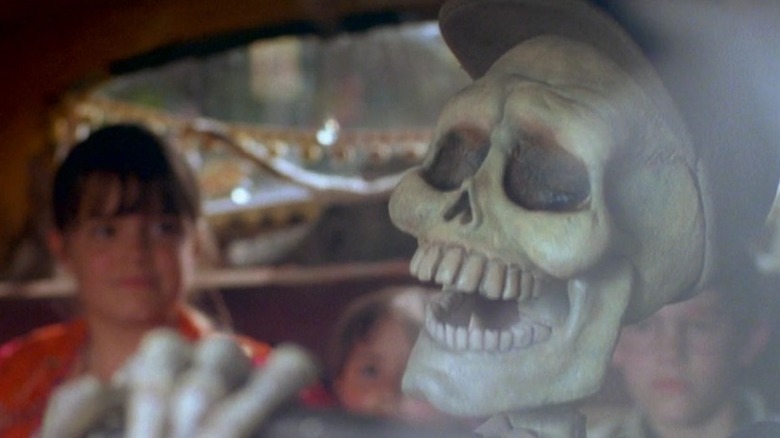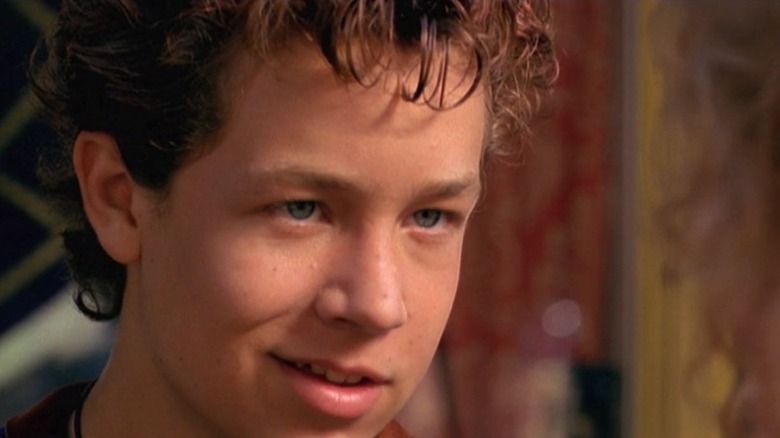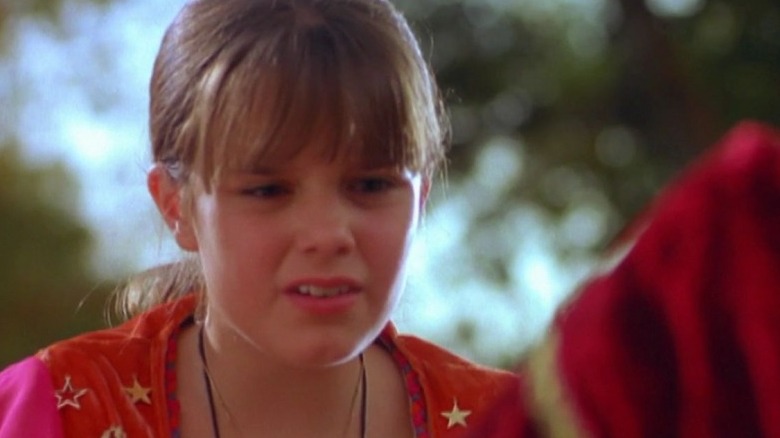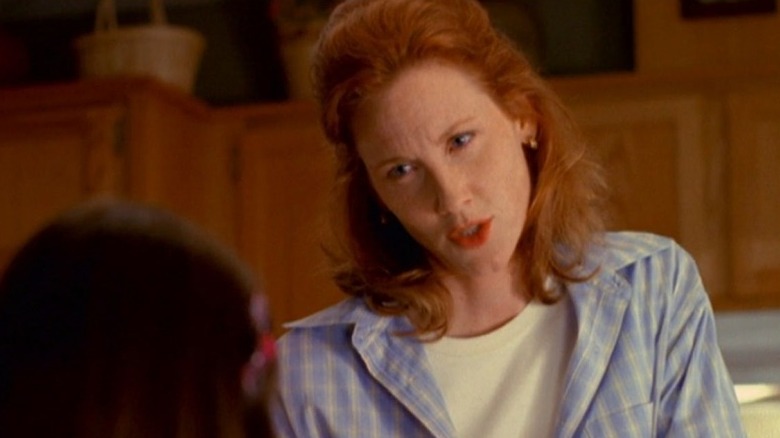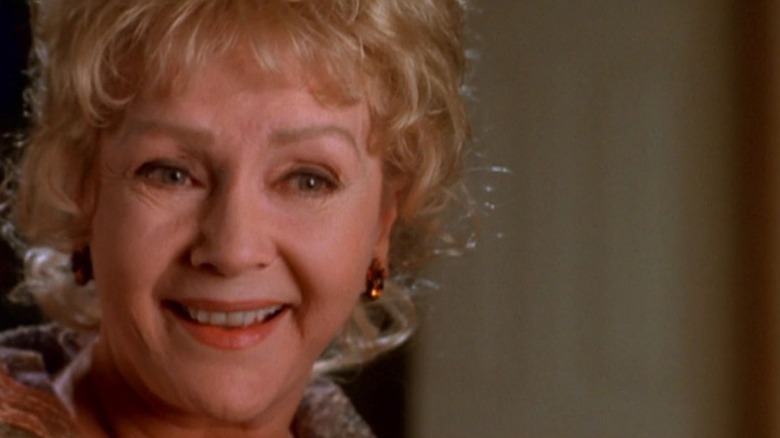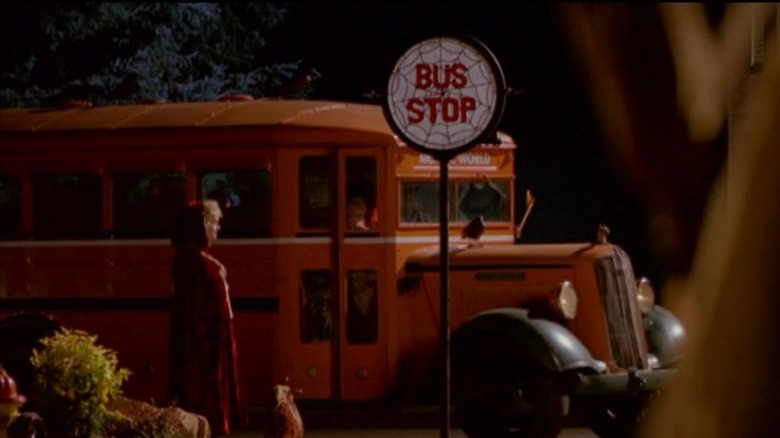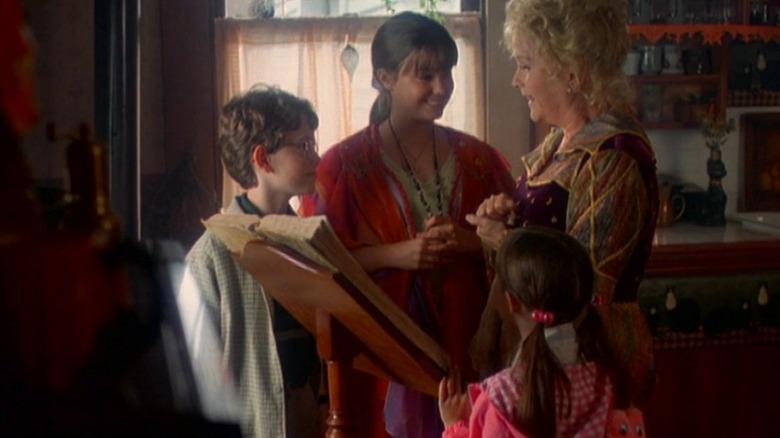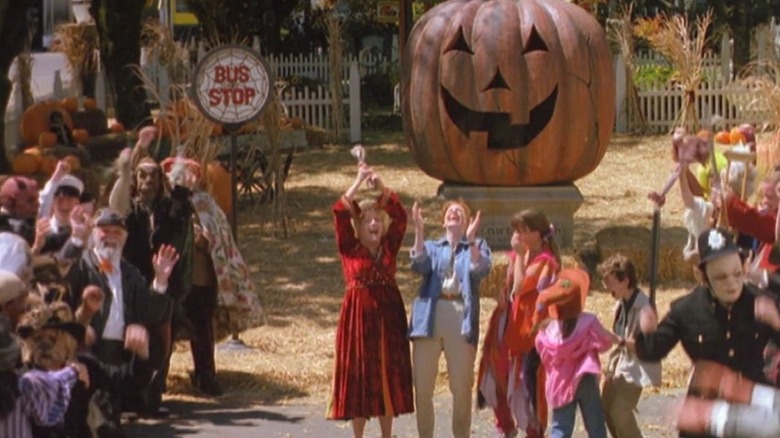Things Only Adults Notice In Halloweentown
Revisiting things from childhood sometimes yields surprising discoveries. For example, your elementary school seemed huge when you were a student there, but now it's strikingly small. It didn't change — you did. Time has a way of shifting your perspective. The same is true when revisiting childhood movies.
What once burst open your imagination now might instead prompt new observations of its production quality or new revelations about its subtext — things that simply were not on your radar when you watched it as a kid.
"Halloweentown" is a solid example of this. The made-for-TV film debuted as a Disney Channel Original Movie in 1998, and started a franchise. Three additional "Halloweentown" movies premiered in the following years, and many kids dreamed of hopping aboard a flying school bus to visit the magical town themselves. How does the film hold up today, and what might have gone over your head when you watched it all those decades ago? Let's find out. Here are things only adults notice in "Halloweentown."
Debbie Reynolds really did that
Most kids probably enjoy "Halloweentown" for what it is and don't think twice about the cast. Adults, on the other hand, might be surprised to see Debbie Reynolds as Grandmother Aggie Cromwell — not just in a brief cameo, either, but rather a starring role. An accomplished, Oscar-nominated actress with decades of cinema credits to her name, most children probably aren't aware of what a force Debbie Reynolds is and how big a deal it is for her to be in a Disney Channel Original Movie.
Reynolds rose to fame in the 1950s when she starred in classics like "Singin' in the Rain." She was nominated for an Oscar for her leading role in 1964's "The Unsinkable Molly Brown" and headlined "The Debbie Reynolds Show" in 1969.
Her appearance in "Halloweentown" showed she was still Hollywood royalty, even if the stardust is lost on young viewers. Nonetheless, even if kids don't know who she is, they still get a memorable performance as Grandma Aggie all the same.
Reynolds would return for all three "Halloweentown" sequels, and also later appeared in other Disney shows like "Kim Possible" and "Kick Buttowski." Reynolds passed away in 2016, the same week as her daughter — another force of the silver screen, Carrie Fisher.
Would Snape teach a cooking class in the Muggle world?
Grandma Cromwell likens brewing a potion in Halloweentown to being a similar practice as cooking in the mortal world. She says one of her potions doesn't work very well because she's using "instant" and it's better to "make it from scratch." She then refers to the instructions as "recipe."
It's interesting that potion-making and cooking would be compared in this universe. In essentially every other magic-themed work of fiction, brewing a potion is depicted as a dark, brooding practice, something of an aesthetic contrast to the generally cheery, bright disposition that cooking typically receives in popular culture. If we were to translate the same parallels to another wizarding franchise, "Harry Potter," it could be fun to imagine that Professor Snape is a skilled foodie. He'd certainly channel his inner Gordon Ramsay in whatever he'd make. In Halloweentown, the art of potion-making is spun on its head to not be something reserved for a dungeon, but something as simple as Grandma Cromwell making a trip to the grocery store.
The broom salesman is giving Beetlejuice vibes
When Grandma Cromwell takes Marnie shopping for her first broomstick, adults might experience some deja vu at the sight of the broomstick salesman. His black-and-white pinstriped costume bears a striking resemblance to the iconic wardrobe of Beetlejuice. The namesake of the 1988 Tim Burton film wears nearly identical apparel throughout the entire movie. As he begins talking, it's clear this is more than just a visual homage. He's basically Beetlejuice reincarnated.
As the character continues in his scene, his voice and personality clearly mimic Michael Keaton. His body language is cartoonishly exaggerated, even with sound effects accompanying his arm movements. He lists the features of the broomstick with gusto, and then teases Marnie, "This broomstick's the top of the line, if you think you can handle it!" A flashy salesman casually insulting customers? Beetlejuice used the same tactics when convincing houseguests to bring him back to life.
The kids whine excessively
While having wide appeal, "Halloweentown" is made for a family-friendly network with kids as its primary audience. As such, the story is told from kids' point of view, including the gripes that the kid characters have about their parents. This is not a phenomenon exclusive to "Halloweentown." Practically any show on Disney Channel or Nickelodeon depicts parental figures as buffoons, often siding with the kids' point of view in any parent/child conflict — again, because the show is made for that perspective.
Because of this, the audience is meant to empathize with the protagonist of "Halloweentown," 13-year-old Marnie. She and her two siblings are deprived of any and all Halloween festivities by their protective mother. That's a seemingly valid reason to be upset as a kid, and Marnie and her sibs are vocal about their discontent.
To younger viewers, the characters' pleas might seem warranted. When watching the movie as an adult, though, they're borderline insufferable. At the slightest inconvenience, they whine, pout, and talk back to their mom in a way that would land many viewers at home in the doghouse if they took the same tone with their parents. Other movies (like "Turning Red," for example) achieve this adolescent angst with more finesse by humanizing the teenage protagonist rather than just making her a brat.
Is that a Roger Rabbit reference?
When Marnie and her siblings need a ride to their grandmother's house, they're picked up by a cab driver named Benny. Aside from being a skeleton, Benny is an eccentric wisecrack who cares just as much about joking as he does about driving. If that sounds familiar, it's because it's the exact same occupation, personality, and name of Benny the cab from "Who Framed Roger Rabbit." Come to think of it, Halloweentown being a hidden haven to a specific group of fictional beings sounds a lot like Toontown.
It's not a stretch to imagine "Who Framed Roger Rabbit" being on the brain of the "Halloweentown" filmmakers. The Robert Zemeckis-directed movie was just shy of a decade old when "Halloweentown" debuted in 1998 and would have still been part of the zeitgeist of Hollywood. The similarities between the drivers is uncanny. When Benny the cab comes to the aid of Eddie Valiant in "Who Framed Roger Rabbit," the anthropomorphic car screeches to a halt and shouts, "So Valiant, you call a cab or what?!" Similarly, in "Halloweentown" when Kalabar summons Benny the skeleton, the driver screeches in front of him and remarks with a nearly identical cadence, "Howdy, mayor! What's the rush?!"
Halloweentown would be at home in teen soap
The drama of it all! So much of "Halloweentown" is played seriously, but instead comes across almost comical with how overly dramatic it is. Take this one scene as an example: When the egocentric Luke offers to show the Cromwell children around town, albeit while insulting them, their grandmother replies, "Perhaps some other time." Marnie's brother Dylan then chimes in, "Yeah. Like never!" The line is delivered as the diss of the century and without a hint of irony. The script is filled with moments like this: exchanges meant to be mic drops that instead feel like satire to any viewer over the age of 12.
These scenes invite a fun comparison for adults who are familiar with soap operas, or even teen dramas, that have a gusto similar to "Halloweentown." "All My Children," "Dawson's Creek," even the parody show-within-the show "Moody's Point" from "The Amanda Show"– Drop their theme music as padding under pretty much any scene in "Halloweentown" and it totally works.
It's not Marnie's 13th Halloween
Part of the main story of "Halloweentown" is driven by Grandma Aggie advocating for Marnie's training as a witch. With a darkness setting over her home world, Aggie needs the help of a fellow witch in her blood line. With Marnie's mother revoking her magical past, Marnie might be Aggie's only hope. The story gets set into motion by the timing of Grandma Aggie's visit to the mortal world to enlist Marnie for her training. The whole reason Aggie is so adamant on this particular year is because it's Marnie's 13th Halloween — "wonderfully lucky number 13," as she puts it. It's supposedly the perfect time to begin Marnie's bewitching education.
Grandma Aggie prefaces her plea by saying, "If I'm not mistaken," which is fitting because she is mistaken, or rather the script contradicts itself in different places. Elsewhere, Marnie says she's 13 years old. The two statements cannot co-exist because, well, that's not how aging works. If Marnie is already 13 years old, this would be her 14th Halloween. The only way it would be her 13th Halloween is if she's 12. If it helps to think about it this way, when you're zero years old, you have your first Halloween, and so on. Oops!
The whole family lies to each other constantly
Don't trust anyone in this family! No matter their generation, they repeatedly tell each other that they're going to do something, and then immediately do the opposite. The mom represses her kids' true identities as having magical heritage, keeping them from an entire world they know nothing of. The grandmother, fully active in the magical world, promises not to out the mom but then totally does. Right after promising not to say a word, she reads the children a book all about the town! The kids likewise promise their mom they'll stay in on Halloween and then just leave. Upon their arrival to Grandma Aggie's house, the elder smiles with glee while saying the kids' mom will be upset when she realizes they're gone.
These are all vital plot points necessary to move the story forward in the movie, but adults might find it exhaustive at how every character straight-up lies to your face and doesn't give it a second thought. Granted, it feels trivial to get worked up about this within the context of a made-for-TV movie for kids about a magical village of witches in the sky. Still, you can't help but notice this family has toxic red flags everywhere.
There are an alarming amount of close-up shots
Filmmaking isn't just about the story being told, it's about the way that story is visually presented to the viewer. The director might employ a number of different styles of shots that subconsciously communicate different feelings to the audience. In watching "Halloweentown," you may notice frequent use of close-up shots, or shots that get extremely close to an actor's face in a way that takes up a lot of the frame. In seeking the layered meaning behind why close-up shots are most often used, we can perhaps learn something new about "Halloweentown."
According to Master Class, typically a filmmaker will utilize close-ups of a character to communicate a "strong emotional connection." If that's the case for "Halloweentown," the audience is meant to do an awful lot of connecting because the camera is obsessed with constantly having the characters' faces take up the entire screen. There doesn't seem to be a pattern behind when the shot happens, as it's present in a variety of scenes that have different tones. Marnie's aggravated by her mother's rules? Close-up. Grandma Aggie inquiring about Marnie having any powers? Close-up. Kalabar threatening the town? Close-up. This movie really wants you to be connected emotionally!
Everyone is blissfully unobservant on the bus
Sometimes you have to forego logic and suspend disbelief when you watch a movie. When the story involves flying broomsticks and magic potions, it's not exactly the most realistic tale to begin with. There's one scene in "Halloweentown" that particularly asks the audience to just not think about it too hard, because it simply would be implausible to imagine happening in real life.
When Grandma Aggie catches her bus back home, her grandchildren follow her. Something about this bus must make people not notice their surroundings. Marnie and Dylan hop aboard and shuffle to the back of the bus. A few moments later, they're startled when a passenger turns around and reveals himself to be a monster. Looking around, they see the bus is filled with them. So they walked across the entire length of the bus and didn't notice any of these people until they sat down?
Marnie and Dylan also don't realize their sister Sophie followed them onto the bus. This fact is revealed when the bus arrives at its destination, but feels improbable. The camera deliberately showed Marnie and Dylan boarding the bus and the bus doors closing immediately after they do!
Meanwhile, Grandma Cromwell, sitting directly at the front of the bus, somehow doesn't notice all three kids boarding. Sure, it's dark, but they would've walked right past her! For as smart as these witches and wizards are, the bus seems to cast its own spell on them.
Time is wonky in Halloweentown
Grandma Aggie explains that "time works differently in Halloweentown," though the specifics are left to our imagination and don't make much sense. At separate points in the script, throw-away lines about time paint a blurry picture.
Grandma Aggie says her witch's brew is from a recipe she picked up in the sixth century. Elsewhere, Benny the cab driver tells the kids that Grandma Aggie has lived in the same house for 200 years. When the kids are worried about getting home, Grandma Aggie ensures them, "Two hours there might be two days here, or two weeks if we're on vacation!"
It's not that these necessarily contradict each other, it's just that they arguably create more confusion than clarity. Given that Grandma Aggie can only travel to the mortal world once a year on Halloween night, and time seemingly stretches longer in Halloweentown, just how long does she perceive that time to be between visits? If she's lived since at least the sixth century, how old is she really? Is Marnie's mom older than she looks too? These questions are left unanswered, prompted by fragments of dialogue that seem to service individual moments rather than be thought of in connection to one another.
We might be trained to think this way thanks to years of stitching together precise timelines from the likes of Marvel and DC, but "Halloweentown" should hardly be held to the same standard, and perhaps it's best to just get let it go.
Mark Mothersbaugh composed the score
The opening credits hold a surprise for fans of film scores or '80s synth music. While you might remember the main instrumental theme from "Halloweentown" from when you were a kid, as it's repeated numerous times throughout the movie, you may not have realized it was composed by none other than Mark Mothersbaugh. Frontman of the band Devo, Mothersbaugh helped bring the world hits like "Whip It" with his brother Bob Mothersbaugh and other bandmates Jerry Casale, Bob Casale, and Alan Myers. Marvel fans may know Mark from the trippy score he wrote for "Thor: Ragnarok" in 2017.
The composer has a long, impressive résumé of other work before and after "Halloweentown." Around the same time as the film's 1998 debut, Motherbaugh wrote music for "Rugrats" on Nickelodeon. Over the decades, he also composed 1996's "Happy Gilmore," 2003's "The Even Stevens Movie," 2012's "21 Jump Street," 2021's "The Mitchells vs. the Machines," and 2022's "Our Flag Means Death," among many others. In story and style, these projects may seem to be polar opposites from one another. If you listen closely within their orchestrations, though, you may notice familiar signatures indicative of Mothersbaugh's style.
